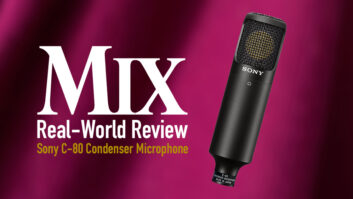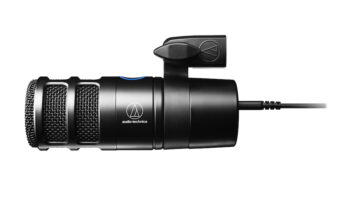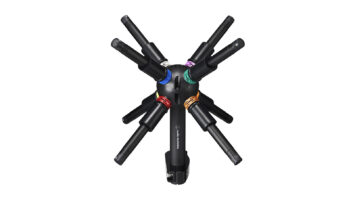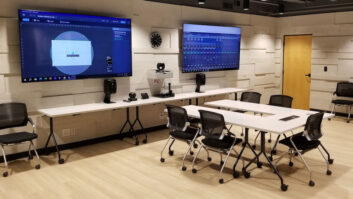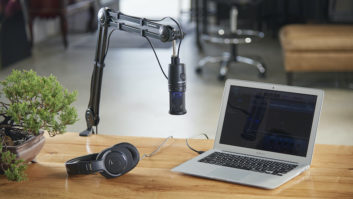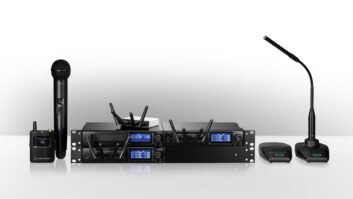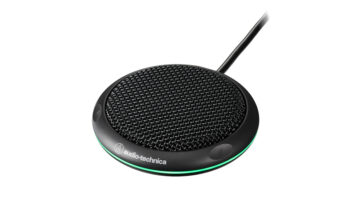The AT2020 is Audio-Technica’s entry-level, side-address studio condenser mic. It brings the company’s build quality and consistency into the same street price range ($100) as many of the Shanghai-made Neumann U87 look-alikes.
This is a no-frills mic that lacks a highpass filter or shock-mount. It has a single pickup pattern — cardioid — and therefore needs only one diaphragm. That diaphragm has a fixed charge and is 16 mm, about halfway between most small- and large-diaphragm models.
Audio-Technica lists the 2020’s frequency response at 20 to 20k Hz. Between those points, it has a slight high-end rise (about 3 dB) between 5 and 20 kHz. At about 200 Hz, it starts a gentle dip that gets to about 5 dB down at 80 Hz. With a slightly bright but neutral sound and a 144dB specified input handling capability, the 2020 is more of an all-purpose mic than a specialist model with an opinion about what it’s picking up.
SOLID BUILD
The AT2020 ships in a foam-fitted cardboard box, but it also comes with a vinyl pouch for storage. In place of a shock-mount, it has a pivoting stand clip and includes the two standard thread sizes. The clip is nicely made and holds the mic securely in position; however, I found that the mic sounded smoother in a standard shock-mount. It’s hard to say whether that’s due to the way AT2020 couples with the mic stands I used, which are not particularly fancy.
Regardless, this mic doesn’t suffer from the body resonances that a lot of budget mics have when you tap them; in fact, it appears to be built every bit as well as the more expensive ($895 list) AT4050 in my arsenal. After discovering that the shock-mount helped, I mounted the 2020 in the AT4050’s shock-mount (AT8441) for this review. (The company says its AT8458 shockmount [$99] also fits the AT2020. — Eds.)
GREAT ON GUITAR
The first test was to try the AT2020 on the acoustic guitar part for a library cue I was working on. I also put up the AT4050 and an MXL V57M for comparison, running them through a Millennia Media STT-1’s mic preamp section in its uncolored solid-state (as opposed to tube) setting.
During my tests, the average mic position was about 14 inches away from the location where the sound hole meets the neck. Rather than being clinical and putting the mics in the same exact position, I moved each one to where it sounded best. At least in a spot-miking situation, I consider this the only valuable way to audition mics because that’s how mics are actually used.
Both Audio-Technica mics had a similar high-end boost and featured the pick noise that the test part needed, whereas the MXL V57M mic had less. While the Audio-Technica mics have a similar overall sound, the higher-end 4050 sounded rounder and had less of a dry, constrained sound. To remedy the lack of low-end roundness, I moved the 2020 closer to the instrument for some proximity boost, making it sound more similar to the 4050. With its more rolled-off low end and drier sound, the AT2020’s unequalized sound was actually the most appropriate of the three for this particular guitar part. The AT2020 is a credible choice for strummed, percussive acoustic guitar parts.
CHECKING OTHER SOURCES
Next, I tried the three mics on recorder, solo cello, shaker and tambourine. Both the 2020 and 4050 sounded slightly bright — yet reasonably faithful — to the sound of the actual cello, while the V57M emphasized the cello’s resonance too much.
The 2020 would not be my first choice for shaker, which wants a more exaggerated low and/or high end. However, it worked fine on tambourine (an indicator of solid transient response) and especially on recorder, producing a brighter rendition of the original sound.
In general, I would recommend using the AT2020 very close to the source. Its proximity effect is fairly controlled, but I also found that room tone tends to spotlight its less-pleasant characteristics rather than its strengths. Normally, one would make this suggestion for a noisy mic, but that’s not the issue here. The 2020 is intended for personal and project studio applications in which you’d normally want to mike close to the source to disguise the untreated recording rooms.
WORTHY CONTENDER
With the AT2020, Audio-Technica has succeeded in bringing its standard of construction quality into the entry-level price range. While it didn’t excel in every situation, it displayed admirable qualities when used up close to maximize the direct-to-reflective balance, emphasizing its stronger qualities. It also worked very well on strummed acoustic guitar.
Some inexpensive mics are character mics, designed to add an interesting color to the sound. With them, you tend to focus on that color rather than the sound quality. The problem is that they don’t work well on everything. Conversely, the AT2020 is designed to be pleasingly bright, yet accurate-sounding; to my ears, the trade-off to its greater versatility is that this design makes the shortcomings inherent to its price range more apparent. Nevertheless, it would make a credible choice for anyone looking for an affordable, all-purpose mic to start or build up their collection.
Audio-Technica, 330/686-2600, www.audio-technica.com.
Nick Batzdorf is an L.A.-based composer, producer, engineer and writer.
